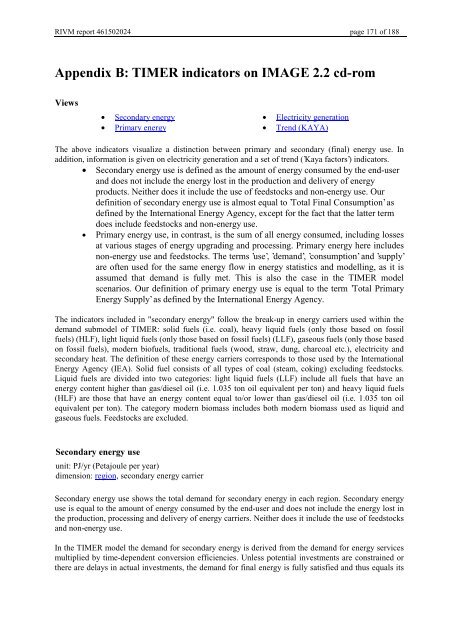Targets IMage Energy Regional (TIMER) Model, Technical ...
Targets IMage Energy Regional (TIMER) Model, Technical ...
Targets IMage Energy Regional (TIMER) Model, Technical ...
You also want an ePaper? Increase the reach of your titles
YUMPU automatically turns print PDFs into web optimized ePapers that Google loves.
RIVM report 461502024 page 171 of 188<br />
$SSHQGL[%7,0(5LQGLFDWRUVRQ,0$*(FGURP<br />
9LHZV<br />
• Secondary energy<br />
• Primary energy<br />
• Electricity generation<br />
• Trend (KAYA)<br />
The above indicators visualize a distinction between primary and secondary (final) energy use. In<br />
addition, information is given on electricity generation and a set of trend (’Kaya factors’) indicators.<br />
• Secondary energy use is defined as the amount of energy consumed by the end-user<br />
and does not include the energy lost in the production and delivery of energy<br />
products. Neither does it include the use of feedstocks and non-energy use. Our<br />
definition of secondary energy use is almost equal to ’Total Final Consumption’ as<br />
defined by the International <strong>Energy</strong> Agency, except for the fact that the latter term<br />
does include feedstocks and non-energy use.<br />
• Primary energy use, in contrast, is the sum of all energy consumed, including losses<br />
at various stages of energy upgrading and processing. Primary energy here includes<br />
non-energy use and feedstocks. The terms ’use’, ’demand’, ’consumption’ and ’supply’<br />
are often used for the same energy flow in energy statistics and modelling, as it is<br />
assumed that demand is fully met. This is also the case in the <strong>TIMER</strong> model<br />
scenarios. Our definition of primary energy use is equal to the term ’Total Primary<br />
<strong>Energy</strong> Supply’ as defined by the International <strong>Energy</strong> Agency.<br />
The indicators included in "secondary energy" follow the break-up in energy carriers used within the<br />
demand submodel of <strong>TIMER</strong>: solid fuels (i.e. coal), heavy liquid fuels (only those based on fossil<br />
fuels) (HLF), light liquid fuels (only those based on fossil fuels) (LLF), gaseous fuels (only those based<br />
on fossil fuels), modern biofuels, traditional fuels (wood, straw, dung, charcoal etc.), electricity and<br />
secondary heat. The definition of these energy carriers corresponds to those used by the International<br />
<strong>Energy</strong> Agency (IEA). Solid fuel consists of all types of coal (steam, coking) excluding feedstocks.<br />
Liquid fuels are divided into two categories: light liquid fuels (LLF) include all fuels that have an<br />
energy content higher than gas/diesel oil (i.e. 1.035 ton oil equivalent per ton) and heavy liquid fuels<br />
(HLF) are those that have an energy content equal to/or lower than gas/diesel oil (i.e. 1.035 ton oil<br />
equivalent per ton). The category modern biomass includes both modern biomass used as liquid and<br />
gaseous fuels. Feedstocks are excluded.<br />
6HFRQGDU\HQHUJ\XVH<br />
unit: PJ/yr (Petajoule per year)<br />
dimension: region, secondary energy carrier<br />
Secondary energy use shows the total demand for secondary energy in each region. Secondary energy<br />
use is equal to the amount of energy consumed by the end-user and does not include the energy lost in<br />
the production, processing and delivery of energy carriers. Neither does it include the use of feedstocks<br />
and non-energy use.<br />
In the <strong>TIMER</strong> model the demand for secondary energy is derived from the demand for energy services<br />
multiplied by time-dependent conversion efficiencies. Unless potential investments are constrained or<br />
there are delays in actual investments, the demand for final energy is fully satisfied and thus equals its
















